Exploring Bandar Anzali: Gateway to the Caspian Sea
Bandar Anzali, nestled along the southern coast of the Caspian Sea in Iran, holds a rich tapestry of history, culture, and economic significance. This comprehensive exploration delves into the city’s origins, maritime trade, natural landscapes, and modern developments, showcasing its pivotal role as a strategic port and cultural hub in the region.
Historical and Cultural Heritage
Bandar Anzali, formerly known as Bandar-e Pahlavi, boasts a heritage dating back centuries. Originally a small fishing village, its strategic location on the Caspian Sea facilitated trade and cultural exchange along the ancient Silk Road routes. Over time, it evolved into a bustling port city, influenced by Persian, Russian, and Caucasian cultures, evident in its architecture, cuisine, and traditions.
Maritime Trade and Economic Vitality
The port of Bandar Anzali plays a pivotal role in Iran’s maritime trade, serving as a gateway for imports and exports. Its strategic location offers access to the vast resources of the Caspian Sea, supporting industries such as fishing, shipping, and tourism. The port’s modern infrastructure and ongoing development projects underscore its economic importance and potential for international trade expansion.
Natural Beauty and Tourist Attractions
Bandar Anzali is renowned for its picturesque landscapes and natural attractions. The Anzali Lagoon, a UNESCO-protected wetland, teems with biodiversity and serves as a haven for migratory birds. Visitors flock to its shores for birdwatching, boating excursions, and exploring the lush forests of Gilan province. The city’s vibrant bazaars, historic mosques, and traditional tea houses offer glimpses into local life and culture.
Cultural Diversity and Culinary Delights
The cultural mosaic of Bandar Anzali is reflected in its diverse population and culinary traditions. Influences from neighboring Azerbaijan and Russia blend with Persian flavors to create a unique gastronomic experience. Local dishes such as Mirza Ghasemi (smoked eggplant dip), Baghali Polo (rice with fava beans), and Anar Bij (pomegranate stew) tantalize the taste buds and reflect the region’s agricultural abundance.
Modern Developments and Future Prospects
In recent years, Bandar Anzali has witnessed significant infrastructure investments and urban development projects aimed at enhancing livability and economic growth. The expansion of transportation networks, including roadways and railways, connects the city to major Iranian cities and international markets. Plans for industrial zones and technological parks aim to diversify the local economy and attract investment in high-tech industries.
Challenges and Sustainability
Despite its economic potential, Bandar Anzali faces challenges related to environmental conservation, urban planning, and sustainable development. Efforts to preserve the Anzali Lagoon and mitigate pollution are critical for maintaining ecological balance and supporting local livelihoods dependent on natural resources. Balancing economic growth with environmental stewardship remains a priority for stakeholders and policymakers.
Conclusion
In conclusion, Bandar Anzali stands as a vibrant testament to Iran’s maritime heritage, cultural diversity, and economic resilience. From its humble beginnings as a fishing village to its current status as a dynamic port city, it continues to evolve as a gateway to the Caspian Sea and a hub for trade, tourism, and cultural exchange. As it navigates the challenges of the modern era, Bandar Anzali remains poised for continued growth and prosperity in the heart of the Caspian region.
The area of this port is about one million square meters and has a nominal capacity of 11 million tons.
Advantages and features of Anzali port:
-
The largest port on the shores of the Caspian Sea and equipped with modern unloading and loading facilities
-
Ranks third among the country’s ports after Imam Khomeini and Shahid Rajaei Port
-
Proximity to the ports of Astrakhan and Lagan in Russia, Krasnodsk in Turkmenistan, Aktau in Kazakhstan and Baku in Azerbaijan.
-
Connection with regional markets and access to the consumer market of over 300 million people in the newly independent countries of the former Soviet Union
-
Being on the route of the North-South International Corridor, which is three times shorter and cheaper than the current route.
-
The location of the port within the free zone, and providing special facilities and facilities for goods owners, traders and investors.
-
Proximity to the largest oil and gas reserves of the Caspian Sea
-
Enjoying tax exemption
-
Access to lead, zinc and iron mines and industrial centers
-
Enjoying the moderate weather conditions of Gilan province
-
Proximity to neighboring industrial provinces and consumer markets
-
Having an equipped marine passenger terminal
Anzali port has been one of the most active ports on the shores of the Caspian Sea and Iran throughout history.
Thank you for being with us until the end of the text.




